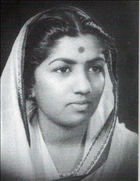


On January 7, 2000 the results of the largest-ever popularity poll conducted in India were announced - Lata Mangeshkar was voted one of the top four Indians of the 20th century. This was a day both of confirmation and celebration. Confirmation of the unmatched mass appeal of a musical genre which many skeptics have time and again tried to put down as silly and superfluous. And celebration of the ultimate recognition of a great artiste whose cultural contribution through that once-tainted artistic medium was so significant that even the highbrow cultural community had to grudgingly acknowledge its impact.
Rather than dismissing this as just one more meaningless list in the mind-boggling millennium mania, we need to take a closer look at the far-reaching issues it highlighted. The Internet survey conducted by a leading Indian daily The Times of India polled in almost 900,000 votes - practically eliminating any regional or racial bias and making it a realistic and relevant reflection of the collective, contemporary Indian psyche.
Voting under four main categories of 'Leaders and Politicians', 'Great Minds and Spiritual Lights', 'Creators of Wealth' and 'Artists and Entertainers', hundreds of Netizens chose the top four names from among 100 eminent personalities who made a difference in 20th century India. Along with
Mahatma Gandhi, Swami Vivekananda and Dhirubhai Ambani, it was Lata who made it to the top.
Many things make this selection interesting. To be up there rubbing shoulders with people of that stature - one of them a world-renowned champion of freedom and peace; another a peerless philosopher who practiced and preached progressive pragmatism without losing perspective of the rich spiritual heritage from the past and yet another, an all-conquering entrepreneur with an uncanny business sense that created a modern industrial empire - requires something extraordinary.
The editors of 'The Times of India whose choice tallied with the survey said, "All of them are self-made individuals; they did not have the advantage of wealth, aristocracy or caste; they fought adversity and believed in action - Karmayogis in true sense. They made India proud and gave the world new ideas, dreams and hopes."
In the case of Lata, all these accolades are apt but fall short of defining her real socio-cultural worth. First and foremost, she is the only woman among the four. In a world still full of male chauvinism, this fact alone deserves applause. Her reign at the top for more than five decades running is nothing short of astonishing. Class, creativity, consistency and commercial appeal combined, she has outshined every male or female artiste in her own arena of Hindi film music. Superstars have come and gone but she remains a respected cultural icon with a timeless and universal emotional appeal to the common Indian.
Somehow that ethereal voice of hers has bonded deeply with Indian hearts. The simplicity of her art form combined with her own artistic genius has made her contribution much more people-oriented than any other performance art and has made her the proverbial 'Voice of India'. How else could one explain her overtaking great names from other fields like Pandit Ravi Shankar, M.S. Subbalakshmi, Pandit Bhimsen Joshi, Raj Kapoor, Amitabh Bachchan, M.F. Hussain, R.K. Narayan, Sunil Gavaskar and the likes with an inevitable regularity in various popularity polls over all these years?
All the major Indian-popularity polls held over the last 25 years have repeatedly confirmed that, in spite of changing trends and tastes of the audiences, Lata's magical musical spell has not only managed to keep itself intact but has grown stronger in its mass appeal. In a way it is strange as advancing age has definitely taken that golden edge off her voice in these very years. But somehow even her commercially more successful but qualitatively much inferior soundtracks in these recent years have enticed the younger generations and made them aware of that special quality that makes her tick. In fact her recent songs have provided the stimulus to many a young mind to explore her priceless repertoire of yesteryear.
Like most great people, her life has not been free of controversies and conflicts but she has weathered these storms with a stoic silence and has let her work speak for her - rather sing for her. In a way she has shown a curious mixture of the qualities of the giants chosen along with her as the century's best. Her songs have provided the freedom of expression to many a beautiful word and tune. The serenity of her voice has brought in peace for many a troubled soul. Then, isn't she a champion of freedom and peace? While remaining loyal to the Indian roots of her music, she has not shied away from adapting according to the changing times. Isn't this progressive pragmatism without losing the perspective of traditional past? While reigning over her awe-inspiring musical empire she has shown an astute understanding of winning trends and a certain degree of - at times unpleasant - ruthlessness. Isn't this a sound and modern business strategy at work?
This amazing lady in white has shown it all. Ambition and achievement; class and courage; dedication and dourness; performance and pride. If one artiste deserved this honour, she did!
For me, this verdict was never in doubt. For those who questioned her place as the most influential Indian artist of the 20th century, I believe the question has been answered once morel in the most emphatic manner possible!